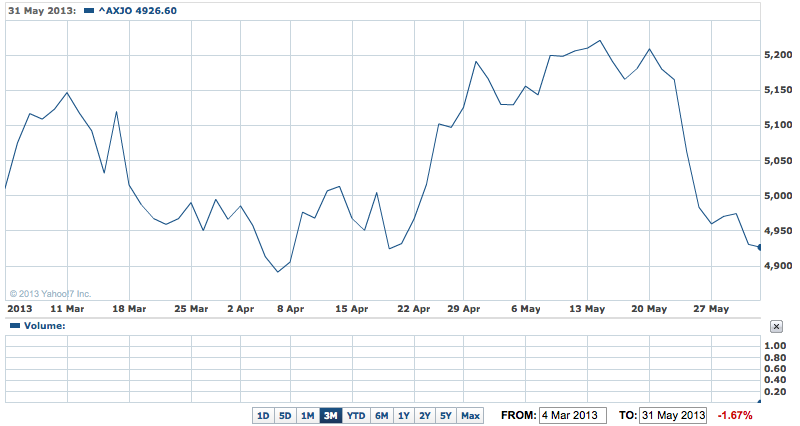Nervous May might have become June on Saturday, but that won’t have an impact on the local market opening.
It is going to be a rough day’s trading on the market today after the weak and uncertain finish in New York on Saturday morning, our time.
A combination of worries about the health and strength of the US economy (which will again be tested this week), the rising volatility in the Japanese market and those fears about China and iron ore prices are rattling confidence levels around the world.
Australia is in the direct line of fire, as we will again see today – not only will there be a weak start following the 57 point fall on share price index futures on Saturday morning, but the health of the China’s huge manufacturing sector will be tested with the final report from the May survey from HSBC in Hong Kong.
That’s out this afternoon and it’s another weak report and markets in Tokyo and Sydney will feel the pain. If there’s no change, nervous investors will find something else to fret about.
Our market ended with a 1.15% loss last week and 5.1% for May, the dollar lost around 5% last month or more and iron ore shed more than 13%.
3-Month ASX200 – Sell In May…

The US dollar ended the week on 95.71 USc and is looking to drift lower if the greenback continues to rise.
Gold, a big factor here, lurched lower on Friday night to end at $US1,393 an ounce.
That was a fall of 2% and the metal was down 5.4% in May, after the 7% drop in April.
That means gold is well and truly into a correction phase and could go lower, especially with no sign of inflation rising in the world’s major economies.
Reuters pointed out that trading volumes in the gold market in New York are 30% down on their moving 200 day average – which indicates a dearth of support for the metal. Short positions have also risen in the past month, which is another bearish point.
US oil futures fell 1.7% on Friday to settle at $US91.97 a barrel For the months of May, US crude futures were down 1.6% from April.
In London, Brent crude oil futures settled fell 1.7% to $US100.39 a barrel. Brent crude was down 1.9% last month.
That weakness is why the Organization of the Petroleum Exporting Countries on Friday kept its output target unchanged at 30 million barrels a day, as expected. Market prices are in line with the wishes of Saudi Arabia for a price level around $US100 a barrel.
The 10-year US bond yield rose to 2.2% early Saturday, our time, up 0.60% since the beginning of May. The 10-year yield is now at its highest point since April 2012.
The Australian market weakness in May didn’t come from those fears about China (which proved to be short-term irritants).
In fact the materials (which include the big miners such as BHP Billiton) rose 2.3% and energy (Woodside, etc) was up 2.5%. The driver there for those gains was the 7% slide in the value of the dollar in May, and not the weak prices.
Consumer discretionary fell 2.7% and the big negative was financials – down 8.9%, despite the solid news flow for banks (profits and dividends) in May.
Looking at the banks – the NAB lost 14.7%, Westpac 15%, the CBA, 9% and the ANZ 13.5%. For the big three March 31 reporters (ANZ, NAB and Westpac), going ex-dividend played a major part in those falls.
That in turn followed not only the announcement of the dividends, but also the ‘dividend washing’ schemes that see big investors buy more shares temporarily (from offshore investors who can’t access the franking credits held by the banks). That saw bank shares rise in April and early May, then fall from around the third week of the month onwards.
Regional Banks such as the Bank of Qld (March 31 balance) and the Bendigo and Adelaide (June 30) fell 12.2% and 10.7% respectively.
Besides some of the big miners, the weaker dollar helped QBE to rise nearly 20% in May (but domestic insurer IAG lost 2.4%).
BHP rose 6.7%, but Rio Tinto fell 1% and Fortescue was off 4.3% as investors indicated they felt the duo were too exposed to the slumping price of iron ore (down 22% from the average March quarter price).
And finally, Transfield lost 42% and Fleetwood Corporation 53.5% as the mining services sector took the brunt of investors’ mining related gloom.













